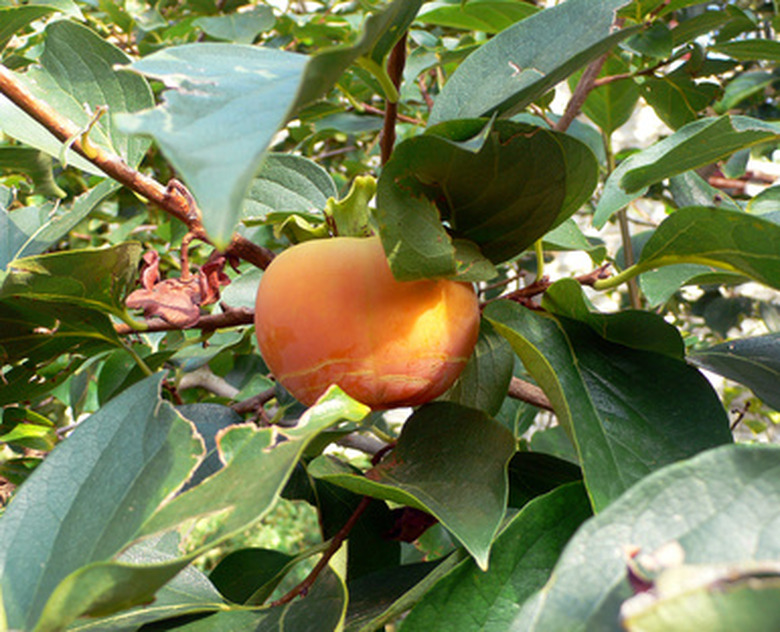Stages Of Fruit On A Persimmon Tree
Native to much of the U.S., from Connecticut to Kansas and south to Florida and Texas, persimmons are baseball-sized fruit with glossy orange or yellow skin and sweet pulp. Persimmon trees (Diospyros) can grow to 60 feet and are deciduous–glossy green leaves change to yellow, pink or purple before dropping in fall. Persimmon trees bloom in spring and some trees require cross-pollination in order to set fruit, so trees should be planted in pairs. Persimmon trees may be astringent or non-astringent. Harvest astringent fruit when it is soft ripe. Plant trees in full sun and water regularly.
Bloom
Persimmon trees bloom in March and flowers differ depending on the tree's sexual expression–though some trees may produce both male and female flowers. Flowers are small and grow on 1-year-old wood. On male trees, flowers are light pink and grow in groups of three, while female trees produce single, cream-colored blooms.
- Native to much of the U.S., from Connecticut to Kansas and south to Florida and Texas, persimmons are baseball-sized fruit with glossy orange or yellow skin and sweet pulp.
- Persimmon trees bloom in spring and some trees require cross-pollination in order to set fruit, so trees should be planted in pairs.
Early Fruit Stage
Some persimmon trees require cross-pollination while other are self-pollinating. In either case, once the bloom has been pollinated, the petals will drop and a small pea-sized fruit will begin to develop. Through the first two months, persimmons will reach about two-thirds of their mature size.
During this stage, the amount of nitrogen present in the fruit decreases dramatically.
Later Fruit Stage
After the first two months, the growth of the fruit will slow, and it will become slightly elongated, as mature fruit is rounded at the top but has a small point at the bottom. The second stage of growth lasts about three months. During this stage, the amount of nitrogen in the fruit decreases at a slower rate before spiking just before maturity.
- Some persimmon trees require cross-pollination while other are self-pollinating.
- During this stage, the amount of nitrogen in the fruit decreases at a slower rate before spiking just before maturity.
Persimmon Tree
Astringent persimmons have an extremely bitter and grainy texture when they are under-ripe. Acids must break down with ripening in order to make them palatable. Once extremely ripe and jelly-like, they are sweet, and excellent for cooking and baking. " The native American Persimmon is also an astringent fruit and is usually harvested after leaf fall. The "Fuyu," grown in USDA hardiness zones 7 through 9, is the most widely eaten of this type. Leaves are large and copious, ranging up to 3 inches wide and 6 inches long. For those seeking a dwarf variety, the "Giant Hanafuya" is one of the smallest persimmons, growing only 10 to 12 feet in height, but maintaining large fruit.
- Astringent persimmons have an extremely bitter and grainy texture when they are under-ripe.
- For those seeking a dwarf variety, the "Giant Hanafuya" is one of the smallest persimmons, growing only 10 to 12 feet in height, but maintaining large fruit.
References
- California Rare Fruit Growers: Persimmon
- California Avocado Society Yearbook: Fruit Growth in Oriental Persimmon
- "Sunset National Garden Book"; the editors of Sunset Books and Sunset Magazine; 1997
- HortNet: Environmental Physiology of Persimmons
- Just Fruits and Exotics: Persimmons
- Lady Bird Johnson Wildflower Center: Diospyros Virginiana (Common Persimmon)
